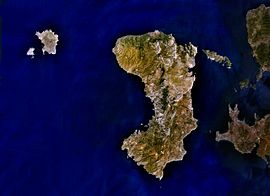Mastiha
| Chios (Χίος) | |
|---|---|
 |
|
| Country | Greece |
| Administrative region | North Aegean |
| Regional unit | Chios |
| Time zone | EET (UTC+2) |
| • Summer (DST) | EEST (UTC+3) |
| Website | www.chios.gr |
Chios Mastiha is a variant of mastic which has a protected designation of origin status in the European Union. The main flavourings used in Chios Mastiha liqueur, mastic distillate and mastic oil, are wholly derived from PDO-certified Chios mastic. Mastic is harvested from the mastic tree (Pistachia lentiscus var. chia), a small evergreen shrub that grows to about two to three meters on rocky terrain on the southern part of the island of Chios. This tree takes fifty years to reach maturity, and can be harvested for mastic from its fifth year onwards. Although the mastic tree can be found around the Mediterranean Sea, the variety that produces the aromatic mastic sap only grows in the southern part of Chios. Chios mastic has also been certified by the Agricultural Products Certification and Supervision Organization as part of the Hellenic Ministry of Rural Development and Food.
Chios Mastiha liqueur is served cold and has a crystal clear colour and a sweet aroma. The ingredients are mastic oil and/or distillate, water, alcohol and sugar.
Mastic is also used for therapeutic purposes, and in cooking and baking.
Mastic has been harvested for at least 2,500 years since Greek Antiquity. The first mention of actual mastic 'tears' was by Hippocrates. Hippocrates used mastic for the prevention of digestive problems, colds and as a breath freshener. Roman emperors used mastic along with honey, pepper, and egg in the spiced wine conditum paradoxum. Under the Byzantine Empire, the trade of mastic was made the emperor’s monopoly. In the Ottoman Empire, the sultan gathered the finest mastic crop to send it to his harem.
At present, there are twenty-four Mastic villages on the island of Chios, which have been dedicated to the cultivation and production of mastic since the Byzantine era. These villages are fortress-like, out of sight from the sea, surrounded by high walls and with no doors at street level, meaning that the villages were entered only by ladders) in order to protect the sap from invaders. Although the liqueur is much younger, it is still tied up with Greek history. Digestive liqueurs, similar to Mastiha but made with grapes, were known as the Greek elixirs before the French Revolution.
...
Wikipedia
